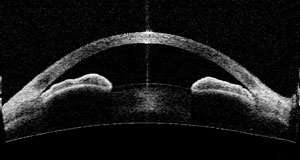An anterior segment optical coherence tomography (AS-OCT) image of the eye's anterior chambers. Credit: © 2018 A*STAR Institute for Infocomm Research
An effective method of screening patients for closed-angle glaucoma has been developed by A*STAR researchers.
In closed-angle glaucoma, the optic nerve is damaged because the aqueous fluid in the eye does not drain properly. This is because the gap between the cornea and the iris, known as the anterior chamber angle, where fluid normally flows through the eye, has narrowed significantly or become blocked. The resulting build-up of pressure within the eye, which can happen rapidly, can cause irreversible blindness.
Current diagnosis of closed-angle glaucoma involves analyzing 'anterior segment optical coherence tomography' (AS-OCT) images, which are cross-sectional pictures of the eye's anterior chambers. However, manual comparison of AS-OCT images, particularly those taken using different systems, takes considerable time and expertise.
"We wanted to create a fully-automated, rapid method for screening AS-OCT images that could ascertain whether closed-angle glaucoma is present," explains Huazhu Fu at A*STAR's Institute for Infocomm Research, who led the project alongside Mani Baskaran at Singapore Eye Research Institute, with scientists from China and the UK. "Our algorithm compares each individual image with a library of exemplar images, before producing a set of clinical parameters from each image that clinicians can use to validate diagnosis."
Fu's team created a reference dataset of labelled images taken by different AS-OCT machines of several thousand individual eyes, both with and without clinically-diagnosed glaucoma. Their algorithm then uses the dataset to analyze newly-uploaded images.
"Although the eye structure shown in every AS-OCT image is different, local regions within each eye are similar. When our algorithm receives a new eye image, it searches the annotated dataset for 'best-fit' images that are the closest match in terms of eye structure and anterior chamber angle, before transferring the labels from these selected library images to the new image," Fu explains.
The algorithm then applies a smoothing technique to refine the structural labeling and ensure it is accurate for each unique eye shape. This allows very precise clinical measurements of the anterior chamber angle and other diagnostic features.
During tests, the algorithm was able to segment and measure one AS-OCT image in ten seconds, providing a potentially invaluable tool for clinicians.
"Our algorithm accurately interprets single or multiple AS-OCT scans, is fully automated and does not depend on specialist training," says Baskaran. "This will significantly improve screening for patients in clinics or community settings and provide support for clinicians."
The team are expanding their trials to larger datasets and aim to incorporate machine-learning techniques into the algorithm to further improve accuracy and performance.
More information: Huazhu Fu et al. Segmentation and Quantification for Angle-Closure Glaucoma Assessment in Anterior Segment OCT, IEEE Transactions on Medical Imaging (2017). DOI: 10.1109/TMI.2017.2703147
























